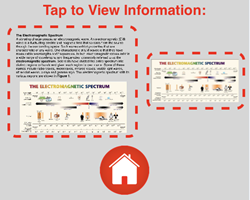About the Science Reasoning Center
 Highly Recommended
Highly RecommendedLike all our Science Reasoning Center activities, the completion of the Electromagnetic Spectrum activity requires that a student use provided information about a phenomenon, experiment, or data presentation to answer questions. This information is accessible by tapping on the small thumbnails found on the bottom right of every question. However, it may be considerably easier to have a printed copy of this information or to display the information in a separate browser window. You can access this information from this page.
The Standards
The Electromagnetic Spectrum task presents information in the form of two short paragraphs and an elaborate diagram of the electromagnetic spectrum. The diagram shows all the regions of the spectrum with a few regions being divided into sub-regions. Wavelength, frequency, and energy/photon values are given. Graphics demonstrate the relative size of the various wavelengths. A final row of the diagram shows typical sources of each type of electromagnetic wave. Questions target students' ability to analyze the diagram, extract information, and make sense of the information. This activity offers strong NGSS alignment.
The following NGSS performance expectation is addressed by this task.
HS-PS4-1:
Use mathematical representations to support a claim regarding relationships amongthe frequency, wavelength, and speed of waves traveling in various media.
Success with Electromagnetic Spectrum requires some degree of understanding or proficiency with respect to ...
- Developing and Using Models (Science and Engineering Practice 2.3)
Develop, revise, and/or use a model based on evidence to illustrate and/or predict the relationships between systems or between components of a system. - Analyzing and Interpreting Data(Science and Engineering Practice 4.1)
Analyze data using tools, technologies, and/or models (e.g., computational, mathematical) in order to make valid and reliable scientific claims or determine an optimal design solution. - Using Mathematics and Computational Thinking (Science and Engineering Practice 5.3)
Use mathematical, computational, and/or algorithmic representations of phenomena or design solutions to describe and/or support claims and/or explanations. - Patterns (Crosscutting Concept 1.1)
Different patterns may be observed at each of the scales at which a system is studied and can provide evidence for causality in explanations of phenomena. - Scale, Proportion, and Quantity (Crosscutting Concept 3.1)
The significance of a phenomenon is dependent on the scale, proportion, and quantity at which it occurs. - Scale, Proportion, and Quantity (Crosscutting Concept 3.3)
Using the concept of orders of magnitude allows one to understand how a model at one scale relates to a model at another scale. - Systems and System Models (Crosscutting Concept 4.2)
Models (e.g., physical, mathematical, computer models) can be used to simulate systems and interactions—including energy, matter, and information flows—within and between systems at different scales.
While the Electromagnetic Spectrum activity addresses the three NextGen Science and Engineering Practices and the four Crosscutting Concepts above, the task draws its greatest inspiration from ACT's College Readiness Standards for Science Reasoning. The task consists of 60 questions organized into 16 Question Groups and spread across the four activities. A single strand (Interpretation of Data - IOD) of the College Readiness Standards is addressed in this activity. The code given for the standard includes three letters to indicate the strand and three numbers to indicate the specific standard within that strand. Higher numbers are indicative of more complex science reasoning skills. The relationship between the questions and the standards is as follows:
Complementary and Similar Resources
The following resources at The Physics Classroom website complement the Electromagnetic Spectrum Science Reasoning Activity. Teachers may find them useful for supporting students and/or as components of lesson plans and unit plans.
The Physics Classroom Tutorial, Light Waves and Color Chapter
Physics Interactives, Light and Color: Electromagnetic Spectrum Infographic
Concept Builders, Light and Color: Spectrum
Minds On Physics, Light and Color Module: Mission LC1, EM and Visible Spectrum
Recommended: Print Passage, Tables, and Graphs
Also see:
